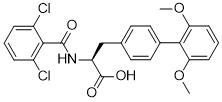TR-14035 is a novel, dual antagonist of alpha4beta7 integrin with IC50 of 7 nM and alpha4beta1 integrin with IC50 of 87 nM. TR14035 blocked the binding of human alpha(4)beta(7) to an (125)I-MAdCAM-Ig fusion protein with IC(50) values of 2.93 and 0.75 nM, respectively. It inhibited binding of soluble ligands to alpha(4)beta(1) or alpha(4)beta(7) on cells of human or rodent origin with similar potency. Under shear flow in vitro. TR-14035 (IC(50) alpha(4)beta(7)/alpha(4)beta(1)=7/87 nM) has completed Phase I studies in Europe.
Physicochemical Properties
| Molecular Formula | C24H21CL2NO5 | |
| Molecular Weight | 474.33 | |
| Exact Mass | 473.079 | |
| Elemental Analysis | C, 60.77; H, 4.46; Cl, 14.95; N, 2.95; O, 16.86 | |
| CAS # | 232271-19-1 | |
| Related CAS # |
|
|
| PubChem CID | 9912743 | |
| Appearance | White to off-white solid powder | |
| Density | 1.3±0.1 g/cm3 | |
| Boiling Point | 604.0±55.0 °C at 760 mmHg | |
| Flash Point | 319.1±31.5 °C | |
| Vapour Pressure | 0.0±1.8 mmHg at 25°C | |
| Index of Refraction | 1.607 | |
| LogP | 3.67 | |
| Hydrogen Bond Donor Count | 2 | |
| Hydrogen Bond Acceptor Count | 5 | |
| Rotatable Bond Count | 8 | |
| Heavy Atom Count | 32 | |
| Complexity | 606 | |
| Defined Atom Stereocenter Count | 1 | |
| SMILES | ClC1C([H])=C([H])C([H])=C(C=1C(N([H])[C@]([H])(C(=O)O[H])C([H])([H])C1C([H])=C([H])C(=C([H])C=1[H])C1C(=C([H])C([H])=C([H])C=1OC([H])([H])[H])OC([H])([H])[H])=O)Cl |
|
| InChi Key | DRSJLVGDSNWQBI-SFHVURJKSA-N | |
| InChi Code | InChI=1S/C24H21Cl2NO5/c1-31-19-7-4-8-20(32-2)21(19)15-11-9-14(10-12-15)13-18(24(29)30)27-23(28)22-16(25)5-3-6-17(22)26/h3-12,18H,13H2,1-2H3,(H,27,28)(H,29,30)/t18-/m0/s1 | |
| Chemical Name | N-(2,6-Dichlorobenzoyl)-4-(2,6-dimethoxyphenyl)-L-phenylalanine | |
| Synonyms |
|
|
| HS Tariff Code | 2934.99.9001 | |
| Storage |
Powder-20°C 3 years 4°C 2 years In solvent -80°C 6 months -20°C 1 month |
|
| Shipping Condition | Room temperature (This product is stable at ambient temperature for a few days during ordinary shipping and time spent in Customs) |
Biological Activity
| Targets | α4β7 (IC50=7 nM); α4β1 (IC50=87 nM) |
| ln Vitro | At 1 μM, TR14035 completely prevents RPMI-8866 cells from adhering to MAdCAM-Ig, with an IC50 of roughly 0.01 μM [2]. |
| ln Vivo | In a rat model of allergic asthma, TR-14035 (3 mg/kg; ig) dramatically decreases airway hyperresponsiveness to serotonin (5-HT) [3]. Oral administration of TR-14035 is used (10 mg/kg in rats and 10 mg/kg in dogs) [4]. TR-14035 is caused by a high plasma clearance after intravenous injection (3 mg/kg in rats and 3 mg/kg in dogs) with values of 3865 and 1664 mL/h/kg, respectively [4]. |
| Enzyme Assay | TR-14035 is a novel, dual antagonist of alpha4beta7 integrin with IC50 of 7 nM and alpha4beta1 integrin with IC50 of 87 nM. |
| Animal Protocol |
Animal/Disease Models: Male Brown Norway rats (250-300 g)[3] Doses: 3 mg/kg Route of Administration: po (oral gavage), 1 h before and 3 h after antigen challenge Experimental Results: Suppressed antigen-induced airway hyper-responsiveness and inflammation. Animal/Disease Models: Male SD (Sprague-Dawley) rats (250-320 g)[4] Doses: 3 mg/kg for iv; 10 mg/kg for oral (pharmacokinetic/PK Analysis) Route of Administration: intravenous (iv) injection and oral administration Experimental Results: Oral bioavailability (17.1%) , Cmax (0.18 μg eq./mL), T1/2 (0.28 h). Animal/Disease Models: Male beagle dogs[4] Doses: 3 mg/kg for iv; 10 mg/kg for oral (pharmacokinetic/PK Analysis) Route of Administration: intravenous (iv) administration and oral administration Experimental Results: Oral bioavailability (13.2%), Cmax (0.10 μg eq./mL), T1/2 (0.81 h). |
| ADME/Pharmacokinetics |
Metabolism / Metabolites (S)-2-(2,6-Dichlorobenzamido)-3-(2',6'-dimethoxy-[1,1'-biphenyl]-4-yl)propanoic acid has known human metabolites that include 2-[(2,6-dichlorobenzoyl)amino]-3-[4-(2-hydroxy-6-methoxyphenyl)phenyl]propanoic acid. |
| References |
[1]. Synthesis and SAR of N-benzoyl-L-biphenylalanine derivatives: discovery of TR-14035, a dual alpha(4)beta(7)/alpha(4)beta(1) integrin antagonist. Bioorg Med Chem. 2002 Jun;10(6):2051-66. [2]. Alpha(4)beta(7)/alpha(4)beta(1) dual integrin antagonists block alpha(4)beta(7)-dependent adhesion under shear flow. J Pharmacol Exp Ther. 2002 Jul;302(1):153-62. [3]. A small molecule, orally active, α4β1/α4β7 dual antagonist reduces leukocyte infiltration and airway hyper-responsiveness in an experimental model of allergic asthma in Brown Norway rats. Br J Pharmacol. 2006 Mar; 147(6): 661–670. [4]. Pharmacokinetics and metabolism of TR-14035, a novel antagonist of a4ss1/a4ss7 integrin mediated cell adhesion, in rat and dog. Xenobiotica. |
Solubility Data
| Solubility (In Vitro) |
DMSO: ~95 mg/mL ( 200.28 mM) Water: <20 mg/mL Ethanol: Insoluble |
| Solubility (In Vivo) |
Solubility in Formulation 1: ≥ 2.5 mg/mL (5.27 mM) (saturation unknown) in 10% DMSO + 40% PEG300 + 5% Tween80 + 45% Saline (add these co-solvents sequentially from left to right, and one by one), clear solution. For example, if 1 mL of working solution is to be prepared, you can add 100 μL of 25.0 mg/mL clear DMSO stock solution to 400 μL PEG300 and mix evenly; then add 50 μL Tween-80 to the above solution and mix evenly; then add 450 μL normal saline to adjust the volume to 1 mL. Preparation of saline: Dissolve 0.9 g of sodium chloride in 100 mL ddH₂ O to obtain a clear solution. Solubility in Formulation 2: ≥ 2.5 mg/mL (5.27 mM) (saturation unknown) in 10% DMSO + 90% Corn Oil (add these co-solvents sequentially from left to right, and one by one), clear solution. For example, if 1 mL of working solution is to be prepared, you can add 100 μL of 25.0 mg/mL clear DMSO stock solution to 900 μL of corn oil and mix evenly. (Please use freshly prepared in vivo formulations for optimal results.) |
| Preparing Stock Solutions | 1 mg | 5 mg | 10 mg | |
| 1 mM | 2.1082 mL | 10.5412 mL | 21.0824 mL | |
| 5 mM | 0.4216 mL | 2.1082 mL | 4.2165 mL | |
| 10 mM | 0.2108 mL | 1.0541 mL | 2.1082 mL |
